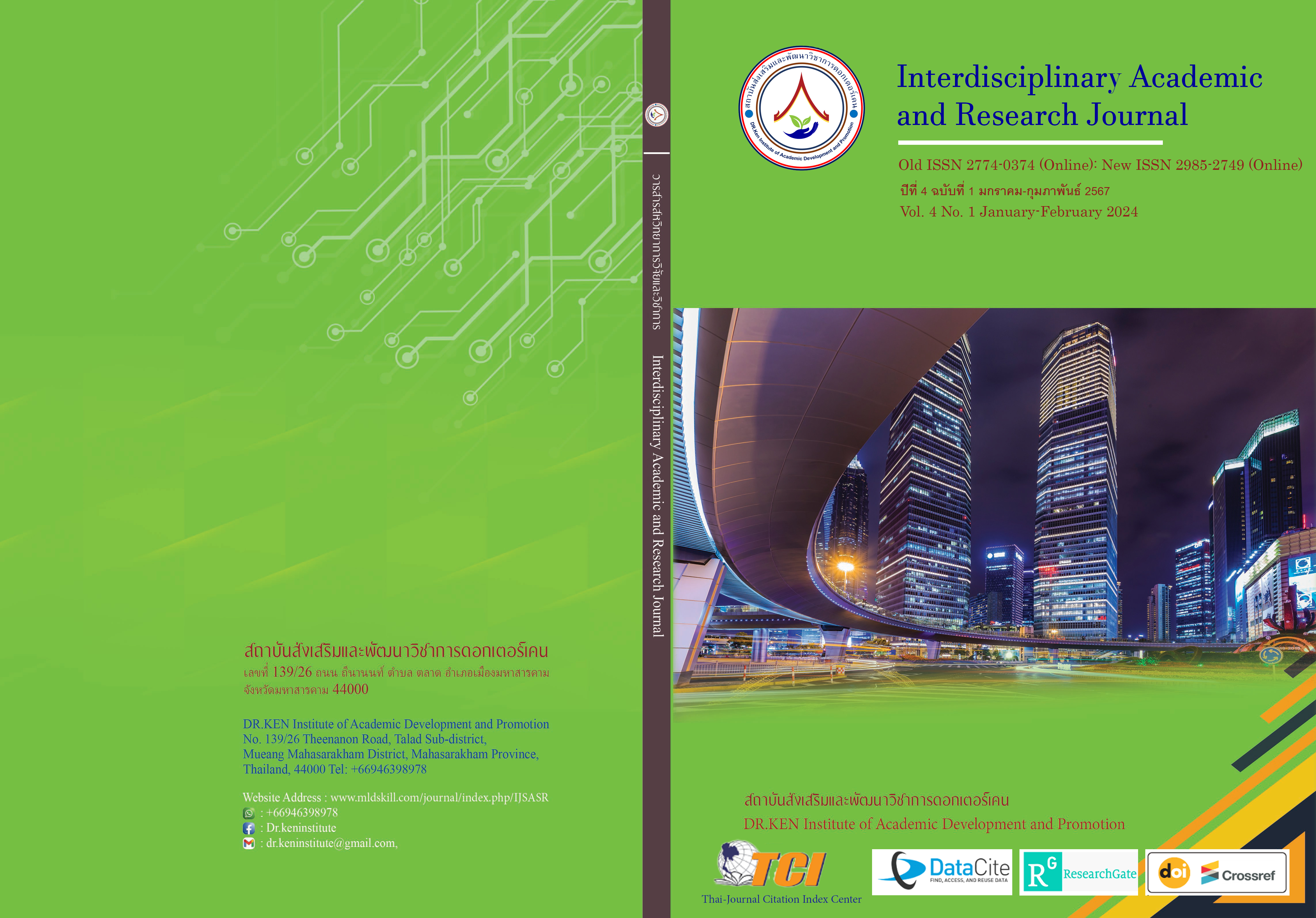Efficiency of Using Electronic Document System (MSU-EDS) of Administrative Assistant in Mahasarakham University
DOI:
https://doi.org/10.60027/iarj.2024.272734Keywords:
Electronic Document system; , EDS system;, Administrative AssistantAbstract
Background and Aims: The correspondence system is a system related to document management. It is an important factor in organizational development in organizing document management regulations within the department. So that searching and tracking can be done easily and quickly, which the traditional document system There are complicated steps. Including redundancy of work in many steps. Resulting in delays and waste of resources and budget. This research has the objective of studying (1) To study the efficiency of using the electronic document system (MSU-EDS) of administrative staff within Maha Sarakham University. (2) To propose guidelines for increasing efficiency in using the electronic document system (MSU-EDS) of administrative staff and personnel within Maha Sarakham University.
Methodology: The population and sample used for the study are Personnel performing administrative duties under the faculties and departments of Maha Sarakham University, totaling 72 people, using a specific selection method. This research is a survey research. The researcher conducted a reliability test. The questionnaires were to a sample of 30 people to check reliability by analyzing the Cronbach’s Alpha analysis test, which was equal to 0.849 before using the questionnaires to survey the actual sample population. Tools used to distribute in this research It is a questionnaire and a rating scale divided into 5 levels.
Results: the results are reported using descriptive statistics and the results are displayed in the form of percentages divided into 5 sections. The research found that the majority of administrative staff are female. Most are 21-30 years old and have an education level. Most are bachelor's degrees. Working status: Most are university staff Most working periods range from 4-6 years. Agencies affiliated with Most of them have 1 person per group and there are only three departments with 2 personnel per department. The frequency of use in the EDS system is every day from 8:30 A.M. to 10:00 A.M. for use. The main job is to receive books. Notification of export documents and upload documents into the system The administrative worker will periodically activate the EDS during work. Because other tasks need to be done simultaneously. Therefore, there is no clear time limit. To enable Codes to be carefully preserved by administrative workers. Including support and assistance for both new and old personnel to have the convenience of obtaining EDS codes for continued use. Keep up to date with the news situation by giving advice, and guidance on various steps, including training how to use them for personnel in the agency. It also encourages personnel in the agency to use documents through the EDS system as the main channel. Likewise, operators also use the EDS system in their work regularly.
Conclusion: The research concludes that most administrative employees are women, aged 21-30 years, with bachelor's degrees. and have 4-6 years of experience. EDS systems are used on a daily basis for specific tasks. The focus is on maintaining code and support personnel. These findings highlight the system's important role as the primary channel for document use by both administrative and agency staff.
References
กนกวรรณ มาป้อง. (2566) . ระบบสารบรรณอิเล็กทรอนิกส์ สำหรับหน่วยงานในกระทรวงสาธารณสุข. Retrieve from: https://itjournal.moph.go.th/page/detail/25
กุสุมาลย์ ประหา. (2557) . คุณภาพด้านการทำงานของระบบงานสารบรรณอิเล็กทรอนิกส์ ของมหาวิทยาลัยเทคโนโลยีราชมงคลอีสาน. การศึกษาค้นคว้าอิสระ,วิชาเอกการจัดการทั่วไป คณะบริหารธุรกิจ มหาวิทยาลัยเทคโนโลยี ราชมงคลธัญบุรี.
จันทนา ประสงค์ศิลปกุล. (2547) . แรงจูงใจ พฤติกรรมการทำงาน และความจงรักภักดีของพนักงานธนาคาร กสิกรไทย สายงานระบบ. สารนิพนธ์บริหารธุรกิจมหาบัณฑิต สาขาวิทยาการจัดการ, มหาวิทยาลัยศรีนคริ นทรวิโรฒ.
ชาญณรงค์ ศิริสุขโภคา. (2557) . การศึกษาการรับรู้ พฤติกรรมการทำงาน และความเชื่อมั่นในความสามารถของระบบงานสารบรรณอิเล็กทรอนิกส์ ที่มีผลต่อประสิทธิผลในการทำงาน ของพนักงานในองค์กรรัฐวิสาหกิจแห่งหนึ่งในเขตกรุงเทพมหานคร. บริหารธุรกิจมหาบัณฑิต,มหาวิทยาลัยกรุงเทพ.
เดชา สุพรรณทอง. (2548) . การศึกษาสภาพปัจจุบัน สภาพที่ยอมรับได้ และความคาดหวังต่อการใช้ระบบสารบรรณอิเล็กทรอนิกส์ ในสำนักงานปลัดกระทรวงศึกษาธิการ. มหาวิทยาลัยเทคโนโลยีพระจอมเกล้าธนบุรี.
นฤทธิ์ มัยรัตน์. (2549) . สภาพปัจจุบัน สภาพขั้นต่ำที่ยอมรับได้และความคาดหวังเกี่ยวกับการใช้ระบบสารบรรณอิเล็กทรอนิกส์ ของสำนักงานนโยบายและแผนการขนส่งและจราจร กระทรวงคมนาคม.กรุงเทพฯ: มหาวิทยาลัยเทคโนโลยีพระจอมเกล้าธนบุรี.
นลพรรณ บุญฤทธิ์. (2558) . ปัจจัยที่มีผลต่อประสิทธิภาพ ในการปฏิบัติงานของบุคลากรองค์การบริหารส่วน จังหวัดชลบุรี. สาขาวิชาการจัดการสาธารณะ วิทยาลัยพาณิชยศาสตร์ มหาวิทยาลัยบูรพา.
ปริศนา มัชฌิมา และคณะ. (2555) . พฤติกรรมและประสิทธิภาพการใช้ระบบสารบรรณอิเล็กทรอนิกส์ (e- Office) ของมหาวิทยาลัยราชภัฎสวนดุสิต. มหาวิทยาลัยราชภัฎสวนดุสิต.
มาลินี นกศิริ. (2559) . ปัจจัยที่มีผลต่อประสิทธิภาพ ในการปฏิบัติงานของพนักงานบริษัท ธรรมรักษ์ ออโต้ พาร์ท จำกัด. สาขาวิชาบริหารธุรกิจ, มหาวิทยาลัยราชภัฎราชนครินทร์.
รวงทิพย์ หัวใจดี. (2548) . พฤติกรรมการใช้ระบบสารสนเทศ ปัญหาและความต้องการสารสนเทศบน เครือข่ายอินทราเน็ตของพนักงานการไฟฟ้านครหลวง. วิทยานิพนธ์ศิลปศาสตรมหาบัณฑิต สาขาวิชาบรรณารักษศาสตร์และสารสนเทศศาสตร์ มหาวิทยาลัยราชภัฏบ้านสมเด็จ เจ้าพระยา
ราชกิจจานุเบกษา. (2548) . ระเบียบสำนักนายกรัฐมนตรีว่าด้วยงานสารบรรณ (ฉบับที่2) พ.ศ. 2548. เล่ม 122 ตอนพิเศษ 99 ลงวันที่ 23 กันยายน 2548
รุ่งทิพย์วุฒิคัมภีร์. (2555) . ประสิทธิภาพการปฏิบัติงานของบุคลากรเมื่อน าระบบสารบรรณ อิเล็กทรอนิกส์มาใช้พัฒนางานสารบรรณ กรมวิชาการเกษตร กระทรวงเกษตรและสหกรณ์. วิทยานิพนธ์ปริญญามหาบัณฑิต, มหาวิทยาลัยราชภัฏอุบลราชธานี
วิโรจน์ ยิ้มขลิบ และคณะ. (2555) . ปัจจัยที่มีผลต่อความพึงพอใจสำหรับการใช้งานระบบสารบรรณ อิเล็กทรอนิกส์: กรณีศึกษา มหาวิทยาลัยเทคโนโลยีราชมงคลพระนคร. มหาวิทยาลัยเทคโนโลยีราชมงคลพระนคร.
ศรีสมพร รอดศิริ. (2551) . ประสิทธิผลการปฏิบัติงานของบุคลกรในการนำระบบงานสารบรรณ อิเล็กทรอนิกส์ มาใช้ในกรมตรวจบัญชีสหกรณ์ กระทรวงเกษตรและสหกรณ์. ศิลปศาสตรมหาบัณฑิต, มหาวิทยาลัยราชภัฏพระนคร.
ศิริกุล รัตนสุวรรณชัย. (2548) . ทัศนคติของพนักงานที่มีผลต่อพฤติกรรมการทำงานและความ จงรักภักดีต่อ องค์กรใน บริษัท เจริญโภคภัณฑ์อาหาร จำกัด (มหาชน) . วิทยานิพนธ์บริหารธุรกิจมหาบัณฑิต มหาวิทยาลัยศรีนครินทร์วิโรฒ.
ศิริพร อัจฉริยโกศล. (2550) . ความรู้ ทัศนคติ และพฤติกรรมการใช้ระบบเครือข่าย Outlook Web Access เป็นเครื่องมือสื่อสารภายในองค์การของพนักงานระดับปฏิบัติการ ธนาคารกรุงเทพ จำกัด [มหาชน]. มหาวิทยาลัยธรรมศาสตร์, กรุงเทพมหานคร. สาขาวิชาการจัดการ, มหาวิทยาลัยศรีนครินทรวิโรฒ.
สมใจ ลักษณะ. (2549) . การพัฒนาประสิทธิภาพในการทำงาน. กรุงเทพฯ: โรงพิมพ์เพิ่มทรัพย์ การพิมพ์.
สารภี สหะวิริยะ. (2562) . ปัญหาการใช้งานระบบเอกสารอิเล็กทรอนิกส์ (E-document) ของบุคลากร คณะวิทยาศาสตร์ และคณะวิศวกรรมศาสตร์, สาขาวิชารัฐประศาสนศาสตร์, มหาวิทยาลัยสงขลานครินทร์. มหาวิทยาลัยสงขลานครินทร์
สำนักงานรัฐบาลดิจิทัล (องค์การมหาชน) (สพร.) (2566) . ระบบสารบรรณอิเล็กทรอนิกส์ (e-Saraban) . Retrieved from: https://www.dga.or.th/th/profile/927/
สุวิภา ดวงผาสุก. (2557) . ความคิดเห็น ความพึงพอใจ และความมีประสิทธิภาพต่อระบบสารบรรณ อิเล็กทรอนิกส์ ขอผู้ปฏิบัติงานระบบสารบรรณ อิเล็กทรอนิกส์ (E-office) กรมราชองครักษ์. คณะบริหารธุรกิจ มหาวิทยาลัยเทคโนโลยีราชมงคลพระนคร.
อัครเดช ไม้จันทร์. (2560) . ปัจจัยที่มีผลต่อประสิทธิภาพในการปฏิบัติงานของพนักงาน กลุ่มอุตสาหกรรมติดตั้ง เครื่องจักรสายการผลิตในจังหวัดสงขลา. ปริญญาบริหารธุรกิจมหาบัณฑิต มหาวิทยาลัยสงขลานครินทร์.
อุชุมพร แก้วขุนทด. (2550) . ความไว้วางใจในผู้นำองค์กร ความไว้วางใจในองค์กรและความจงรักภักดีต่อองค์กรที่มีผลต่อพฤติกรรมและประสิทธิภาพในการปฏิบัติงานของพนักงานบริษัทเนตบีเคเค จำกัด. วิทยานิพนธ์บริหารธุรกิจมหาบัณฑิต, มหาวิทยาลัยศรีนครินทรวิโรฒ.
Downloads
Published
How to Cite
Issue
Section
License
Copyright (c) 2024 Sudarat Yothawong

This work is licensed under a Creative Commons Attribution-NonCommercial-NoDerivatives 4.0 International License.
Copyright on any article in the Interdisciplinary Academic and Research Journal is retained by the author(s) under the under the Creative Commons Attribution-NonCommercial-NoDerivatives 4.0 International License. Permission to use text, content, images, etc. of publication. Any user to read, download, copy, distribute, print, search, or link to the full texts of articles, crawl them for indexing, pass them as data to software, or use them for any other lawful purpose. But do not use it for commercial use or with the intent to benefit any business.
















.png)


